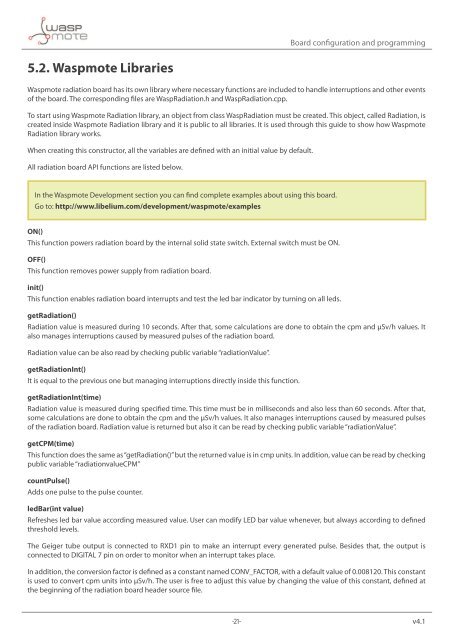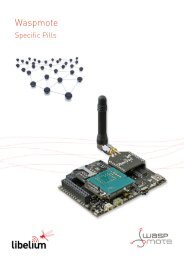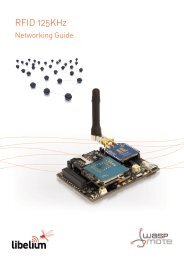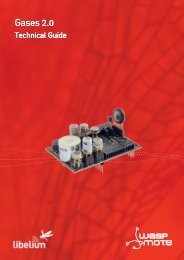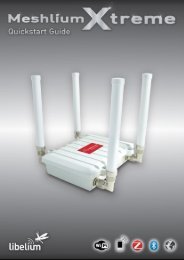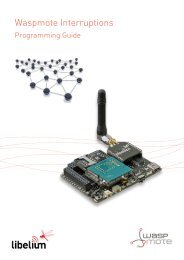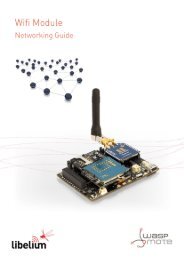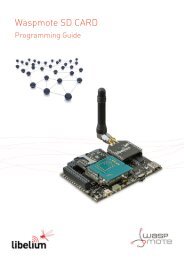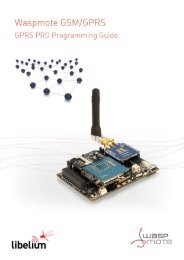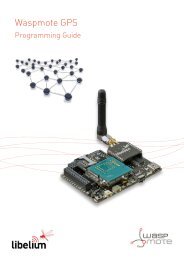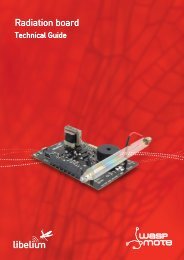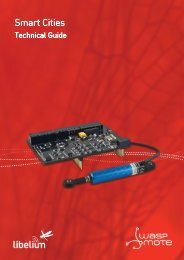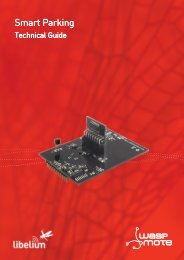Radiation board - Libelium
Radiation board - Libelium
Radiation board - Libelium
You also want an ePaper? Increase the reach of your titles
YUMPU automatically turns print PDFs into web optimized ePapers that Google loves.
Board configuration and programming5.2. Waspmote LibrariesWaspmote radiation <strong>board</strong> has its own library where necessary functions are included to handle interruptions and other eventsof the <strong>board</strong>. The corresponding files are Wasp<strong>Radiation</strong>.h and Wasp<strong>Radiation</strong>.cpp.To start using Waspmote <strong>Radiation</strong> library, an object from class Wasp<strong>Radiation</strong> must be created. This object, called <strong>Radiation</strong>, iscreated inside Waspmote <strong>Radiation</strong> library and it is public to all libraries. It is used through this guide to show how Waspmote<strong>Radiation</strong> library works.When creating this constructor, all the variables are defined with an initial value by default.All radiation <strong>board</strong> API functions are listed below.In the Waspmote Development section you can find complete examples about using this <strong>board</strong>.Go to: http://www.libelium.com/development/waspmote/examplesON()This function powers radiation <strong>board</strong> by the internal solid state switch. External switch must be ON.OFF()This function removes power supply from radiation <strong>board</strong>.init()This function enables radiation <strong>board</strong> interrupts and test the led bar indicator by turning on all leds.get<strong>Radiation</strong>()<strong>Radiation</strong> value is measured during 10 seconds. After that, some calculations are done to obtain the cpm and μSv/h values. Italso manages interruptions caused by measured pulses of the radiation <strong>board</strong>.<strong>Radiation</strong> value can be also read by checking public variable “radiationValue”.get<strong>Radiation</strong>Int()It is equal to the previous one but managing interruptions directly inside this function.get<strong>Radiation</strong>Int(time)<strong>Radiation</strong> value is measured during specified time. This time must be in milliseconds and also less than 60 seconds. After that,some calculations are done to obtain the cpm and the μSv/h values. It also manages interruptions caused by measured pulsesof the radiation <strong>board</strong>. <strong>Radiation</strong> value is returned but also it can be read by checking public variable “radiationValue”.getCPM(time)This function does the same as “get<strong>Radiation</strong>()” but the returned value is in cmp units. In addition, value can be read by checkingpublic variable “radiationvalueCPM”countPulse()Adds one pulse to the pulse counter.ledBar(int value)Refreshes led bar value according measured value. User can modify LED bar value whenever, but always according to definedthreshold levels.The Geiger tube output is connected to RXD1 pin to make an interrupt every generated pulse. Besides that, the output isconnected to DIGITAL 7 pin on order to monitor when an interrupt takes place.In addition, the conversion factor is defined as a constant named CONV_FACTOR, with a default value of 0.008120. This constantis used to convert cpm units into μSv/h. The user is free to adjust this value by changing the value of this constant, defined atthe beginning of the radiation <strong>board</strong> header source file.-21- v4.1


